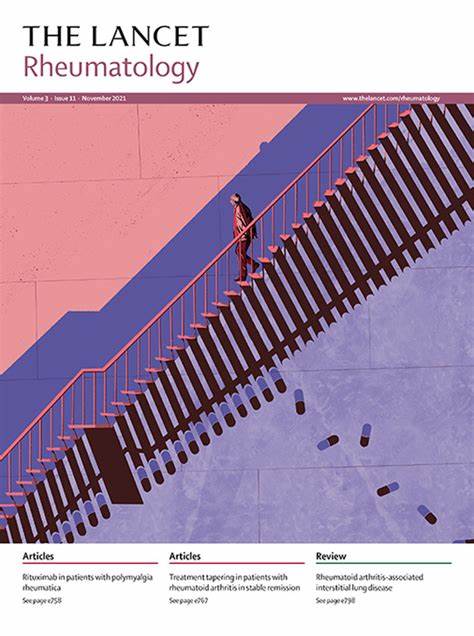Systemic lupus erythematosus in Aboriginal and Torres Strait Islander peoples in Australia: addressing disparities and barriers to optimising patient care
IF 15
1区 医学
Q1 RHEUMATOLOGY
引用次数: 0
Abstract
The first inhabitants of Australia and the traditional owners of Australian lands are the Aboriginal and Torres Strait Islander peoples. Aboriginal and Torres Strait Islander peoples are two to four times more likely to have systemic lupus erythematosus (SLE) than the general Australian population. Phenotypically, SLE appears distinctive in Aboriginal and Torres Strait Islander peoples and its severity is substantially increased, with mortality rates up to six times higher than in the general Australian population with SLE. In particular, Aboriginal and Torres Strait Islander peoples with SLE have increased prevalence of lupus nephritis and increased rates of progression to end-stage kidney disease. The reasons for the increased prevalence and severity of SLE in this population are unclear, but socioeconomic, environmental, and biological factors are all likely to be implicated, although there are no published studies investigating these factors in Aboriginal and Torres Strait Islander peoples with SLE specifically, indicating an important knowledge gap. In this Review, we summarise the data on the incidence, prevalence, and clinical and biological findings relating to SLE in Aboriginal and Torres Strait Islander peoples and explore potential factors contributing to its increased prevalence and severity in this population. Importantly, we identify health disparities and deficiencies in health-care provision that limit optimal care and outcomes for many Aboriginal and Torres Strait Islander peoples with SLE and highlight potentially addressable goals to improve outcomes.
澳大利亚土著居民和托雷斯海峡岛民中的系统性红斑狼疮:消除差距和障碍,优化患者护理。
澳大利亚最早的居民和澳大利亚土地的传统拥有者是土著居民和托雷斯海峡岛民。原住民和托雷斯海峡岛民患系统性红斑狼疮(SLE)的几率是普通澳大利亚人的 2 到 4 倍。从表型上看,系统性红斑狼疮在土著居民和托雷斯海峡岛民中显得与众不同,其严重程度也大大增加,死亡率比一般澳大利亚系统性红斑狼疮患者高出六倍。特别是,患有系统性红斑狼疮的土著居民和托雷斯海峡岛民的狼疮性肾炎发病率更高,进展为终末期肾病的比率也更高。该人群系统性红斑狼疮患病率和严重程度增加的原因尚不清楚,但社会经济、环境和生物因素都可能与之有关,不过目前还没有针对系统性红斑狼疮原住民和托雷斯海峡岛民的这些因素的公开研究,这表明存在着重要的知识缺口。在本综述中,我们总结了有关土著居民和托雷斯海峡岛民系统性红斑狼疮的发病率、患病率、临床和生物学研究结果的数据,并探讨了导致该人群患病率和严重程度增加的潜在因素。重要的是,我们发现了在提供医疗保健服务方面存在的健康差距和不足,这些差距和不足限制了许多患有系统性红斑狼疮的土著居民和托雷斯海峡岛民获得最佳护理和治疗效果,并强调了改善治疗效果的潜在目标。
本文章由计算机程序翻译,如有差异,请以英文原文为准。
求助全文
约1分钟内获得全文
求助全文
来源期刊

Lancet Rheumatology
RHEUMATOLOGY-
CiteScore
34.70
自引率
3.10%
发文量
279
期刊介绍:
The Lancet Rheumatology, an independent journal, is dedicated to publishing content relevant to rheumatology specialists worldwide. It focuses on studies that advance clinical practice, challenge existing norms, and advocate for changes in health policy. The journal covers clinical research, particularly clinical trials, expert reviews, and thought-provoking commentary on the diagnosis, classification, management, and prevention of rheumatic diseases, including arthritis, musculoskeletal disorders, connective tissue diseases, and immune system disorders. Additionally, it publishes high-quality translational studies supported by robust clinical data, prioritizing those that identify potential new therapeutic targets, advance precision medicine efforts, or directly contribute to future clinical trials.
With its strong clinical orientation, The Lancet Rheumatology serves as an independent voice for the rheumatology community, advocating strongly for the enhancement of patients' lives affected by rheumatic diseases worldwide.
 求助内容:
求助内容: 应助结果提醒方式:
应助结果提醒方式:


